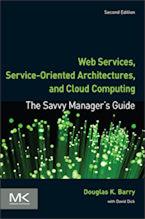Web Services Description Language (WSDL)
Web Services Description Language (WSDL) is a format for describing a Web Services interface. It is a way to describe services and how they should be bound to specific network addresses. WSDL has three parts:
- Definitions
- Operations
- Service bindings
Definitions are generally expressed in XML and include both data type definitions and message definitions that use the data type definitions. These definitions are usually based upon some agreed upon XML vocabulary. This agreement could be within an organization or between organizations. Vocabularies within an organization could be designed specifically for that organization. They may or may not be based on some industry-wide vocabulary. If data type and message definitions need to be used between organizations, then most likely an industry-wide vocabulary will be used. For more on XML vocabularies, click here.
XML, however, is not necessary required for definitions. The OMG Interface Definition Language (IDL), for example, could be used instead of XML. If a different definitional format were used, senders and receivers would need to agree on the format as well as the vocabulary. Nevertheless, over time, XML-based vocabularies and messages are likely to dominate. XML Namespaces are used to ensure uniqueness of the XML element names in the definitions, operations, and service bindings.
Operations describe actions for the messages supported by a Web service. There are four types of operations:
- One-way: Messages sent without a reply required
- Request/response: The sender sends a message and the received sends a reply.
- Solicit response: A request for a response. (The specific definition for this action is pending.)
- Notification: Messages sent to multiple receivers. (The specific definition for this action is pending.)
Operations are grouped into port types. Port types define a set of operations supported by the Web service.
Service bindings connect port types to a port. A port is defined by associating a network address with a port type. A collection of ports defines a service. This binding is commonly created using SOAP, but other forms may be used. These other forms could include CORBA Internet Inter-ORB Protocol (IIOP), DCOM, .NET, Java Message Service (JMS), or WebSphere MQ to name a few.
The following figure shows the relationship of the basic parts of WSDL:

Also see XML vocabularies.
Organization: W3C
More information: WSDL page on the W3C website
Context for Web Services Description Language (WSDL)
Related Articles for Web Services Description Language (WSDL)
Author
Douglas K Barry
Principal
You may use this material for your work or classes. Reprint Policy. Be sure to check the menu at the left for other articles available on this site.
The Savvy Manager's Guide
Douglas K Barry is also the author of a book that explains Web Services, service-oriented architecture, and Cloud Computing in an easy-to-understand, non-technical manner.
Web Services, Service-Oriented Architectures, and Cloud Computing: The Savvy Manager's Guide (Second Edition)
by Douglas K Barry with David Dick
This is a guide for the savvy manager who wants to capitalize on the wave of change that is occurring with Web Services, service-oriented architecture, and—more recently—Cloud Computing. The changes wrought by these technologies will require both a basic grasp of the technologies and an effective way to deal with how these changes will affect the people who build and use the systems in our organizations. This book covers both issues. Managers at all levels of all organizations must be aware of both the changes that we are now seeing and ways to deal with issues created by those changes.

